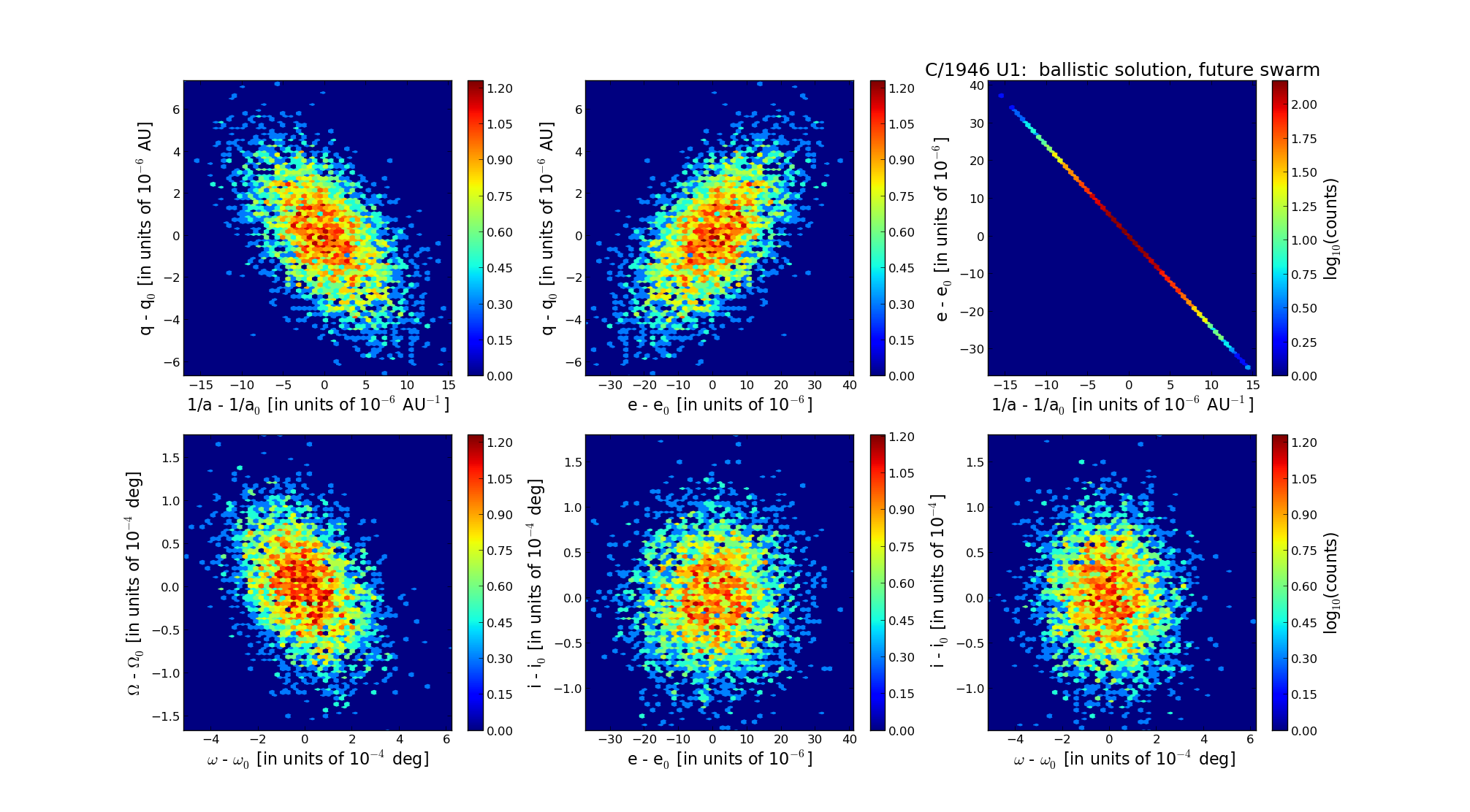C/1946 U1 Bester
more info
Comet C/1946 U1 was discovered on 31 October 1946 by Michiel J. Bester (Boyden Station of Harvard College Observatory, Bloemfontein, South Africa), that is over three months before perihelion passage, and the comet was last seen on 2 October 1948. [Kronk, Cometography: Volume 4].
This comet made its closest approach to the Earth on 29 November 1946 (1.864 au), that is about one month after its discovery.
Solutions given here are based on data spanning over 1.918 yr in a range of heliocentric distances from 2.631 au through perihelion (2.408 au) to 6.316 au.
Pure gravitational orbit determined from all available positional measurements (141 observations) give slightly hyperbolic original barycentric orbit (1a-class orbit); also original orbit given in Minor Planet Center is slightly hyperbolic (97 obs. used, the same arc of data; 1A-class orbit, see MPC).
It was possible to determine the non-gravitational orbits for C/1946 U1 where a small decreases of RMS were obtained. Both these NG-solutions give elliptical original orbit (see original barycentric orbits).
This probably Oort spike comet suffers slight (GR and preferred NG solutions) or small (NG solution: n5) planetary perturbations during its passage through the planetary system. According to both solutions, however, it will enter the planet zone as Oort spike comet in the next perihelion passage (see future barycentric orbits).
More details in Królikowska et al. 2014.
This comet made its closest approach to the Earth on 29 November 1946 (1.864 au), that is about one month after its discovery.
Solutions given here are based on data spanning over 1.918 yr in a range of heliocentric distances from 2.631 au through perihelion (2.408 au) to 6.316 au.
Pure gravitational orbit determined from all available positional measurements (141 observations) give slightly hyperbolic original barycentric orbit (1a-class orbit); also original orbit given in Minor Planet Center is slightly hyperbolic (97 obs. used, the same arc of data; 1A-class orbit, see MPC).
It was possible to determine the non-gravitational orbits for C/1946 U1 where a small decreases of RMS were obtained. Both these NG-solutions give elliptical original orbit (see original barycentric orbits).
This probably Oort spike comet suffers slight (GR and preferred NG solutions) or small (NG solution: n5) planetary perturbations during its passage through the planetary system. According to both solutions, however, it will enter the planet zone as Oort spike comet in the next perihelion passage (see future barycentric orbits).
More details in Królikowska et al. 2014.
| solution description | ||
|---|---|---|
| number of observations | 141 | |
| data interval | 1946 11 02 – 1948 10 02 | |
| data type | perihelion within the observation arc (FULL) | |
| data arc selection | entire data set (STD) | |
| range of heliocentric distances | 2.64 au – 2.41 au (perihelion) – 6.32 au | |
| detectability of NG effects in the comet's motion | comet with determinable NG~orbit | |
| type of model of motion | GR - gravitational orbit | |
| data weighting | YES | |
| number of residuals | 259 | |
| RMS [arcseconds] | 1.29 | |
| orbit quality class | 1a | |
| orbital elements (barycentric ecliptic J2000) | ||
|---|---|---|
| Epoch | 2247 12 28 | |
| perihelion date | 1947 02 07.50375855 | ± 0.00043362 |
| perihelion distance [au] | 2.41255932 | ± 0.00000210 |
| eccentricity | 0.99993675 | ± 0.00001094 |
| argument of perihelion [°] | 348.625816 | ± 0.000140 |
| ascending node [°] | 35.533705 | ± 0.000048 |
| inclination [°] | 108.158906 | ± 0.000048 |
| reciprocal semi-major axis [10-6 au-1] | 26.22 | ± 4.54 |
| file containing 5001 VCs swarm |
|---|
| 1946u1a5.bpl |

